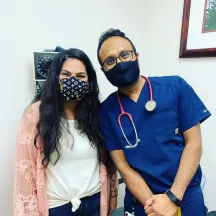Physical activity during & after colorectal cancer treatment
You might need to exercise less than usual or at a lower intensity during and after cancer treatment. The goal is to stay as fit as possible.

How often should I exercise?
The American Cancer Society recommends that cancer survivors take these actions:
- Take part in regular physical activity.
- Avoid inactivity and return to normal daily activities as soon as possible after diagnosis.
- Aim for moderate exercise at least 150 minutes per week.
- Include strength training exercises at least 2 days per week.

What is moderate exercise?
What may be a low- or moderate-intensity activity for a healthy person may seem like a high-intensity activity for some cancer survivors.
Keep in mind that moderate exercise is defined as activity that takes as much effort as a brisk walk.

When will side effects go away?
Every person is different. Many side effects get better within a few weeks after cancer treatment ends, but some can last much longer or even emerge later.
Most people are able to slowly increase exercise time and intensity.
Exercise during cancer treatment
There are several ways regular exercise may help you while you're having treatment:
- Keep or improve your physical abilities (how well you can use your body to do things)
- Improve balance, lower risk of falls and broken bones
- Keep muscles from wasting due to inactivity
- Lower the risk of heart disease
- Lessen the risk of osteoporosis (weak bones that are more likely to break)
- Improve blood flow to your legs and lower the risk of blood clots
- Make you less dependent on others for help with normal activities of daily living
- Improve your self-esteem
- Lower the risk of being anxious and depressed
- Lessen nausea
- Improve your ability to keep social contacts
- Lessen symptoms of tiredness (fatigue)
- Help you control your weight
- Improve your quality of life

Exercise when you are living disease-free or with stable disease
During this phase, physical activity is important to your overall health and quality of life. It may even help some people live longer.
There’s some evidence that getting to and staying at a healthy weight, eating right, and being physically active may help reduce the risk of a second cancer as well as other serious chronic diseases.
Important exercise tips
- Whether you’re just starting exercise or continuing, be sure to check with your doctor about ability and endurance during treatment and after before beginning any exercise program.
- Keep your care team informed about your activity level and exercise throughout your treatment.
- Some people can safely begin or maintain their own exercise program, but many will have better results with the help of a personal trainer, physical therapist, or exercise physiologist.
- Always let the person you are working with know about your cancer diagnosis and any limitations you have. These specially trained professionals can help you find the type of exercise that is right and safe for you. They can also help you figure out how often and how long you should exercise.
- For those with cancer that has spread to the bones or osteoporosis (bone thinning), or problems like arthritis or peripheral neuropathy (numbness in hands or feet), safety and balance are important to reduce the risk of falls and injuries. They may need a caregiver or health professional with them during exercise.
Related reading
Living well with cancerTop resources

A father finds strength in connection
“When I was diagnosed, I needed more than information — I needed connection,” Damien said. “The Alliance was a lifeline."

When will I lose my hair during colorectal cancer treatment?
Chemotherapy often leads to temporary hair loss.

Chris Amos: a patient in a family of survivors
Though facing a colorectal cancer (CRC) diagnosis isn’t easy, Chris continues to show up with grace and courage as he moves through his journey to wellness.





